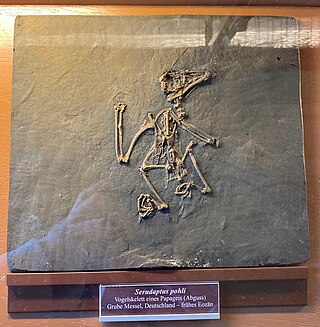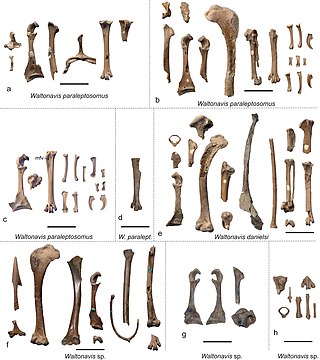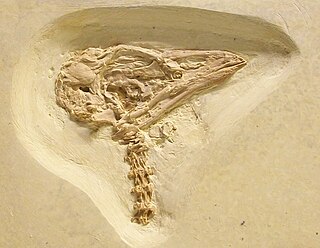Psittacopes is an extinct genus of bird from Middle Eocene. One species is recorded from Messel, Germany, and other three possible species are from London Clay, England, one named ?Psittacopes occidentalis in 2022, and the other two unnamed. Its phylogenetic placement within Aves is uncertain; it was originally interpreted as a parrot, but the phylogenetic analysis conducted by Mayr (2015) recovered it as more closely related to the passerines and the extinct family Zygodactylidae.
Eurofluvioviridavis is a genus of extinct primitive birds from the Middle Eocene Messel Pit, Germany. It contains a single species, Eurofluvioviridavis robustipes. It is related to Avolatavis and Vastanavis, other members of the family Vastanavidae.
Avolatavis is an extinct genus of stem-parrot (pan-psittaciform) or a member of the stem group of Psittacopasseres, known from the early Eocene Fossil Butte Member of the Green River Formation of Wyoming, United States, and from the London Clay of Walton-on-the-Naze. It was first named by Daniel T. Ksepka and Julia A. Clarke in 2012 and the type species is Avolatavis tenens. Gerald Mayr and Andrew C. Kitchener described the second species, A. europaeus, in 2023. Mayr and Kitchener assigned Avolatavis to the family Vastanavidae, which might be early diverging stem group presentatives of Pan-Psittaciformes or stem group representatives of Psittacopasseres.

Messelasturidae is an extinct family of birds known from the Eocene of North America and Europe. Their morphology is a mosaic that in some aspects are very similar to modern hawks and falcons, but in others are more similar to parrots. Initially interpreted as stem-owls, more recent studies have suggested a closer relationship to parrots and passerines. Their ecology is enigmatic.

Halcyornithidae is an extinct family of telluravian birds thought to be related to the Psittaciformes (parrots), Passeriformes (songbirds), and to the extinct Messelasturidae. Halcyornithids have been found in various Eocene formations in Europe and North America. Widespread and diverse in the Early Eocene of North America and Europe, halcyornithids are not found in locales later than the Middle Eocene. Halcyornithids were small, arboreal birds with zygodactyl feet, with two toes facing forwards and two facing back, a trait shared with other tree-dwelling families of Eocene birds like the Zygodactylidae and the messelasturids. The skull of halcyornithids features a ridge of bone above the eye called the supraorbital process, similar to birds of prey. The relationships of the halcyornithids to other birds remain uncertain. Halcyornithids have been proposed as relatives to owls and as a lineage closer to parrots than to songbirds. Most recently, halcyornithids have been identified as the sister group of the clade including parrots and songbirds. It is also possible that Halcyornithidae is paraphyletic with respect to the Messelasturidae.
Danielsraptor is an extinct genus of masillaraptorid bird from the Early Eocene (Ypresian) Walton Member of the London Clay Formation in Essex, United Kingdom. The genus contains a single species, D. phorusrhacoides, known from a partial skeleton.
Nasidytes is an extinct genus of loon (Gaviiformes) that lived during the early Eocene in what is now Great Britain. It contains a single species, N. ypresianus. Nasidytes is the earliest unambiguously identified loon in the fossil record.

Ypresiglaux is an extinct genus of strigiform bird from the Early Eocene London Clay Formation of Essex, United Kingdom and Nanjemoy Formation of Virginia, United States. The genus contains two species: Y. michaeldanielsi, known from a partial skeleton, and Y. gulottai, known from a distal tarsometatarsus.

Lutavis is an extinct genus of potentially afroavian bird from the Early Eocene London Clay Formation of Essex, United Kingdom. The genus contains a single species, L. platypelvis, known from a partial skeleton.

Waltonavis is an extinct genus of potentially leptosomiform bird from the Early Eocene London Clay Formation of Essex, United Kingdom. The genus contains two species: W. paraleptosomus and W. danielsi, both known from partial skeletons.

Psittacomimus is an extinct genus of psittacopedid bird from the Early Eocene London Clay Formation of Essex, United Kingdom. The genus contains a single species, P. eos, known from a partial skeleton.

Minutornis is an extinct genus of parapasserine bird from the Early Eocene London Clay Formation of Essex, United Kingdom. The genus contains a single species, M. primoscenoides, known from a fragmentary skeleton.
Halcyornis is an extinct genus of halcyornithid bird. It is known from a single neurocranium from the Early Eocene London Clay of southeastern England, and contains a single species, Halcyornis toliapicus. The type specimen of Halcyornis was the first fossil bird to be scientifically named.
Charadriisimilis is an extinct genus of charadriiform birds from the Early Eocene (Ypresian) London Clay of Walton-on-the-Naze, United Kingdom. The genus contains a single species, Charadriisimilis essexensis, known from partial postcranial remains.

Cyrilavis is an extinct genus of halcyornithid bird from the Early Eocene Fossil Butte Member of the Green River Formation, United States. The genus contains two species, Cyrilavis olsoni and Cyrilavis colburnorum.
Pseudasturides is an extinct genus of halcyornithid bird from the Middle Eocene Messel pit in Hesse, Germany, and possibly the Isle of Sheppey, United Kingdom. The genus is represented by a single species, Pseudasturides macrocephalus.

Serudaptus is an extinct genus of halcyornithid bird from the Middle Eocene Messel pit in Hesse, Germany. The genus contains one species, Serudaptus pohli, and is known for long, raptorial claws on its zygodactyl feet.
Parapsittacopes is an extinct genus of psittacopedid bird from the Early Eocene London Clay, United Kingdom. The genus contains one species, Parapsittacopes bergdahli.
Eofringillirostrum is an extinct species of bird known from the Early Eocene Green River Formation of the Western United States and from the Messel Pit in Germany. The genus contains two species, Eofringillirostrum boudreauxi and Eofringillirostrum parvulum. They are the earliest known fossil birds to have a finch-like beak.
Sororavis is an extinct genus of bird from the Early Eocene London Clay of Walton-on-the-Naze, United Kingdom. It contains a single named species, Sororavis solitarius. It is a member of the Morsoravidae.







